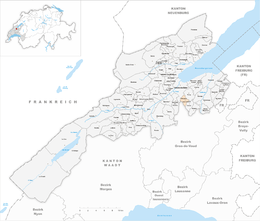Valeyres-sous-Ursins
| Valeyres-sous-Ursins | ||
|---|---|---|

Valeyres-sous-Ursins town hall
|
||
|
||
| Coordinates: 46°45′N 6°39′E / 46.750°N 6.650°ECoordinates: 46°45′N 6°39′E / 46.750°N 6.650°E | ||
| Country | Switzerland | |
| Canton | Vaud | |
| District | Jura-Nord Vaudois | |
| Government | ||
| • Mayor | Syndic | |
| Area | ||
| • Total | 2.88 km2 (1.11 sq mi) | |
| Elevation | 551 m (1,808 ft) | |
| Population (Dec 2015) | ||
| • Total | 245 | |
| • Density | 85/km2 (220/sq mi) | |
| Postal code | 1412 | |
| SFOS number | 5934 | |
| Surrounded by | Essertines-sur-Yverdon, Gressy, Pomy, Ursins | |
| Website |
www Profile (French), SFSO statistics |
|
Valeyres-sous-Ursins is a municipality in the district of Jura-Nord Vaudois of the canton of Vaud in Switzerland.
Valeyres-sous-Ursins is first mentioned in 1184 as de Valeres.
Valeyres-sous-Ursins has an area, as of 2009[update], of 2.9 square kilometers (1.1 sq mi). Of this area, 2.18 km2 (0.84 sq mi) or 75.7% is used for agricultural purposes, while 0.55 km2 (0.21 sq mi) or 19.1% is forested. Of the rest of the land, 0.11 km2 (27 acres) or 3.8% is settled (buildings or roads).
Of the built up area, housing and buildings made up 2.4% and transportation infrastructure made up 1.0%. Out of the forested land, all of the forested land area is covered with heavy forests. Of the agricultural land, 63.2% is used for growing crops and 10.4% is pastures, while 2.1% is used for orchards or vine crops.
The municipality was part of the Yverdon District until it was dissolved on 31 August 2006, and Valeyres-sous-Ursins became part of the new district of Jura-Nord Vaudois.
The municipalities of Cronay, Cuarny, Pomy, Ursins, Valeyres-sous-Ursins and Villars-Epeney are considering a merger on at a date in the future into the new municipality with an, as of 2011[update], undetermined name.
The blazon of the municipal coat of arms is Vert, two Bars wavy Argent, overall a Cup Or.
Valeyres-sous-Ursins has a population (as of December 2015[update]) of 245. As of 2008[update], 4.8% of the population are resident foreign nationals. Over the last 10 years (1999–2009 ) the population has changed at a rate of 32.2%. It has changed at a rate of 27.6% due to migration and at a rate of 5.7% due to births and deaths.
...
Wikipedia




